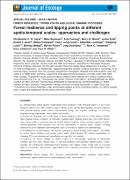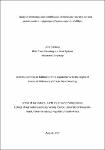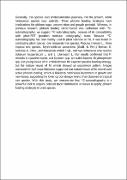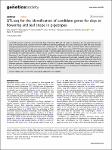Browsing Research Articles by Issue Date
Now showing items 1-20 of 23
-
Pyramiding Fusarium root rot resistance genes and validation of SSR PVBR87 in common bean
(RUFORUM, 2010)This study determined effectiveness of pyramided Fusarium root rot (FRR) resistance genes and validated association of SSR PVBR87 marker with FRR resistance in common bean. A double cross (DC) involving four resistance ... -
Improvement of resistance to Fusarium root rot through gene pyramiding and validation of SSR PVBR87 marker in common bean
(Makerere University, 2011)Fusarium root rot caused by Fusarium solani f. sp. phaseoli is among the most serious diseases of the common bean in Uganda causing total crop loss in susceptible cultivars. Studies have indicated that 2-9 genes located ... -
IMPROVEMENT OF RESISTANCE TO FUSARIUM ROOT ROT THROUGH GENE PYRAMIDING IN COMMON BEAN
(African Crop Science Journal, 2012)Fusarium root rot (FRR), caused by Fusarium solani f.sp. phaseoli, is one of the most serious root rot diseases of common bean (Phaseolus vulgaris L.) throughout the world. Yield losses of up to 84% have been attributed ... -
Forest resilience and tipping points at different spatio-temporal scales: approaches and challenges
(Journal of Ecology, 2015)1. Anthropogenic global change compromises forest resilience, with profound impacts to ecosystem functions and services. This synthesis paper reflects on the current understanding of forest resilience and potential tipping ... -
Genomics-assisted breeding for boosting crop improvement in pigeonpea (Cajanus cajan)
(Frontiers in plant science, 2015)Pigeonpea is an important pulse crop grown predominantly in the tropical and sub-tropical regions of the world. Although pigeonpea growing area has considerably increased, yield has remained stagnant for the last six ... -
Ecophysiological assessment of drought vulnerability of the African tropical tree species Maesopsis eminii Engl
(Ghent University, 2016)Africa is endowed with the second largest block of nature-engineered machinery to sequester carbon: forests. Sadly, the functional traits and responses of this machinery are poorly understood, under non-drought, current ... -
The ecology of Maesopsis eminii Engl. in tropical Africa
(African Journal of Ecology, 2017)Maesopsis eminii is referred to as one of the most widely distributed African tree species. However, its occurrence in Africa has never been mapped and little is known as to how this species can sustain in different ... -
Capacitive water release and internal leaf water relocation delay drought-induced cavitation in African Maesopsis eminii
(Tree physiology, 2017)The impact of drought on the hydraulic functioning of important African tree species, like Maesopsis eminii Engl., is poorly understood. To map the hydraulic response to drought-induced cavitation, sole reliance on the ... -
Plant measurements on African tropical Maesopsis eminii seedlings contradict pioneering water use behaviour
(Environmental and Experimental Botany, 2017)With increased drought events affecting forests globally, little is known about their future impact on Africa’s forests. In particular, we need to gain a better understanding of how key African forest species will respond ... -
Study of inheritance and identification of molecular markers for seed protein content in pigeonpea (Cajanus cajan (L.) Millsp.)
(University of KwaZulu-Natal, Pietermaritzburg, Republic of South Africa, 2017)Pigeonpea is an important source of protein to the vegetarian and poor families around the globe, however, very little is known about the genetic control of seed protein content (SPC) and how it relates with other ... -
Characterization and mapping of Dt1 locus which co‑segregates with CcTFL1 for growth habit in pigeonpea
(Theor Appl Genet, 2017)Pigeonpea (Cajanus cajan) is one of the most important legume crops grown in arid and semi-arid regions of the world. It is characterized with few unique features compared with other legume species, such as Lotus, ... -
Molecular mapping of seed protein content in pigeonpea – a drought tolerant crop of the semi-arid tropics
(: InterDrought, 2017)Pigeonpea is a uniquely drought and heat tolerant crop that provides a major source of dietary protein to nearly a billion people in the tropical and semi-arid tropics of the world. Despite its importance as a source of ... -
Drought Effects on Photosynthesis and Implications of Photoassimilate Distribution in 11C-Labeled Leaves in the African Tropical Tree Species Maesopsis eminii Engl.
(Forests, 2018)Photoassimilate distribution inside leaves is less studied than photosynthesis, and yet the topic is important as it gives insights into the vital roles played by leaves in plant survival. We combined greenhouse measurements ... -
Genetic variation and relationships of total seed protein content with some agronomic traits in pigeonpea (Cajanus cajan (L.) Millsp.)
(Australian Journal of Crop Science, 2018)Seed protein content (SPC) is an important grain quality trait, which impacts the nutritional importance of pigeonpea seed in the diet of over a billion people globally. The present study was carried out to determine ... -
Effect of improved seed system on potato yields in Uganda
(RUFORUM Working Document Series, 2018)Potato seed quality is an important determinant of crop performance, final yield and quality. The quality of seed used by farmers depend on the existing seed system. In Uganda, since the formal sector has limited capacity ... -
11C-autoradiographs to image phloem loading
(Frontiers in Forests and Global Change, 2019)Generally, tree species load photoassimilates passively into the phloem, while herbaceous species load actively. These phloem loading strategies have implications for phloem sugar concentration and growth potential. Whereas, ... -
Development of sequence-based markers for seed protein content in pigeonpea
(Molecular Genetics and Genomics, 2019)Pigeonpea is an important source of dietary protein to over a billion people globally, but genetic enhancement of seed protein content (SPC) in the crop has received limited attention for a long time. Use of genomics-assisted ... -
Seed protein content and its relationships with agronomic traits in pigeonpea is controlled by both main and epistatic efects QTLs
(Scientific Reports, 2020)The genetic architecture of seed protein content (SPC) and its relationships to agronomic traits in pigeonpea is poorly understood. Accordingly, fve F2 populations segregating for SPC and four agronomic traits (seed ... -
Economic Feasibility of Iodine Agronomic Biofortification
(sustainability, 2021)Cost–benefit analysis of (iodine) biofortification at farm level is limited in the literature. This study aimed to analyze the economic feasibility of applying iodine-rich fertilizers (agronomic biofortification) to ... -
QTL-seq for the identification of candidate genes for days to flowering and leaf shape in pigeonpea
(Heredity, 2022)To identify genomic segments associated with days to flowering (DF) and leaf shape in pigeonpea, QTL-seq approach has been used in the present study. Genome-wide SNP profiling of extreme phenotypic bulks was conducted for ...




















